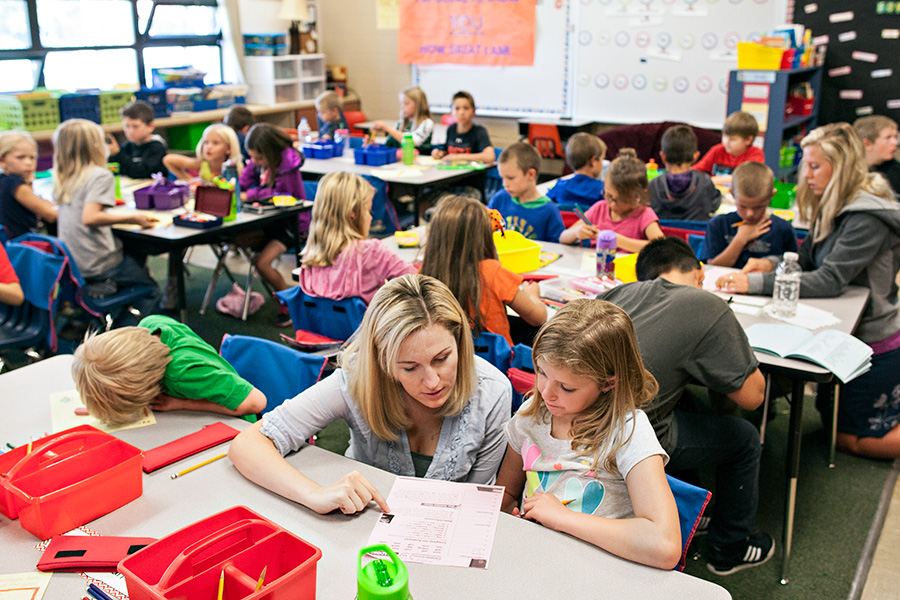To address a budget shortfall, the Kalispell school district is asking voters to approve a $1 million elementary general fund levy, with the goal of adequately funding day-to-day operations and programs without impacting personnel.
Ballots for the levy will be mailed out April 19 and due back by May 8.
Such a levy differs from an infrastructure bond, which can’t be used for operational costs, meaning the bond package approved in October 2016 to build a new elementary school and make upgrades at existing facilities didn’t provide funding for regular operations within the district, including staffing, technology, curriculum and other everyday needs.
“It’s the meat and potatoes,” Superintendent of Kalispell Public Schools Mark Flatau said of general fund operational levies at a Kalispell Chamber of Commerce luncheon at the Red Lion Hotel on Feb. 27. “It’s the dollars that run our schools on a daily basis.”
Speaking to a packed Red Lion ballroom of business leaders, elected officials, educators and other notable community figures, Flatau said the district’s $1.5 million shortfall is primarily due to state budget cuts and rising health-care costs. The funding squeeze is exacerbated by growing enrollment and the added annual costs of operating Rankin Elementary School, which opens in the fall.
The school board voted to move forward with the levy at its meeting last week. To further offset the shortfall, the district has also outlined hundreds of thousands of dollars in budget cuts while dipping into reserve funds.
But school officials say depending on reserve funds isn’t a feasible or sustainable solution for the future, nor can they continue making cuts without impacting the quality of education. The district hopes to avoid cutting jobs, as Flatau said teachers and staff are vital “to our success.”
District officials combed through more than 6,000 line items to identify budget cuts, which for the 2017-18 school year total $353,024 in the elementary district and $360,374 in the high school district. For the upcoming 2018-19 school year, reductions will total $323,776 in the elementary budget and $505,917 in the high school budget.
The $1 million levy would increase property taxes on a $250,000 home by $75.56 per year, or $6.30 per month.
Flatau said the Kalispell public school district is the best he’s encountered in his education career, and he pointed to Kalispell students’ high marks on performance assessments and the high school district’s number five ranking on a list of the best school districts in Montana using data from the U.S. Department of Education. It was the highest-ranking district in Class AA, the state’s largest classification.
Flatau noted that Kalispell hasn’t passed an elementary operational levy since 2012 or a high school levy since 2007. He said Kalispell’s high schools operate at roughly 92 percent of maximum funding and its elementary schools at 93 percent, while many school districts in Montana are regularly at 100 percent and float levies each year as a matter of routine.
All other Class AA elementary districts in Montana operate at 100 percent maximum funding, except Great Falls, which is at 97 percent, according to Flatau. The same is true for Class AA high school districts, with only Billings joining Kalispell as the lone under-maximum districts.
The state provides 80 percent of operational funding, and the difference between 80 and 100 percent — minimum and maximum — depends on local levy support. Flatau said the district works hard to ease the burden on taxpayers, as evidenced by the large gap in years since previous levies were passed and the district’s adherence to operating below maximum funding levels while still excelling.
Flatau noted that some textbooks currently used in the district are over 20 years old. Furthermore, the district doesn’t “want to lose ground” in areas such as special education, security and safety, and information technology.
Due to the state’s budget crunch, the Kalispell school district was set to receive only $401,161 in apportionments from the state for the 2017-18 school year, down from $844,044 the year before, a 53 percent decline. But then a special legislative session and additional cuts further reduced that amount to $268,760, a 68 percent decline. The district’s 2018-19 budget will also see substantially reduced state funding.
Flatau said the district also faces $1.68 million in rising costs for its self-funded health insurance program, due to rate and premium increases, an uptick in participation and underestimated cost projections, including for a number of large claims. The district took out a $725,000 loan to help cover the increased expenses.
At the chamber luncheon, Glacier High School Principal Callie Langhor and Russell Elementary Principal Bill Sullivan spoke to the importance of funding Kalispell’s schools as part of the district’s “green and growing” motto. Langhor said she’s continually impressed with the community and students in Kalispell.
“I absolutely love my job,” she said. “I have the opportunity every day when I get into my car and drive up to that school, I get to work with your kids. They’re incredible people, and they’re our future.”
Flatau encouraged community members to contact the district with questions and to set up public meetings to better understand school finances.
“We did nearly 50 public presentations for the (infrastructure) bond,” he said. “If that’s what we need to do for this, I’m onboard.”
